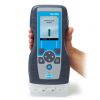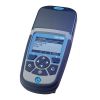Hach SL250 Single-Port Portable Parallel Analyzer
Hach's SL250 Portable Parallel Analyzer (PPA) is an innovative multiparameter water quality meter that allows you to simultaneously perform colorimetric and probe-based measurements.
Features
- Single instrument combines colorimetric and probe-based testing
- All chemicals and processes are entirely contained inside the Chemkey
- Automatic parameter selection and measurement processes for repeatable results
- Free ground shipping
- Expedited repair and warranty service
- Lifetime technical support
- More
Hach's SL250 Portable Parallel Analyzer (PPA) is an innovative multiparameter water quality meter that allows you to simultaneously perform colorimetric and probe-based measurements. The instrument and corresponding Chemkey reagents are easy to use regardless of technical expertise. Compared to traditional powder or liquid reagent methods, Chemkeys use a simplified testing method that requires no sample preparation, making the process significantly easier, faster, and safer while drastically reducing variability in results.
Colorimetric tests include free chlorine, total chlorine, fluoride, high range manganese, zinc, copper, nitrite, dissolved iron, high and low range alkalinity, high and low range orthophosphate, high and low range hardness, peracetic acid, and more.
Probe-based tests include pH, dissolved oxygen, conductivity, and more.
*Not suitable for chloramination applications*
| Battery Life | >200 Chemkey tests per full battery charge |
| Certifications | CE, UKCA, FCC, ISED, RCM, KC |
| Connector | 5-Pin Input Connector: Two M12 connectors for IntelliCal™ probes |
| Data Memory | Memory: 1000 measured values (result, date, time, site ID, user ID) |
| Data Storage | Automatic in Press to Read measurement mode. Manual in Continuous measurement mode |
| Detector | Silicon photodiode |
| Dimensions | 13.08 x 5.89 x 25.83 cm (5.15 x 2.32 x 10.17 in.) |
| Enclosure Rating | IP54 |
| Instrument Bundle | SL250 Single-Port Portable Parallel Analyzer (PPA) |
| Interfaces | Mini USB port |
| Lock Function | For IntelliCAL™ Probes: Press to Read and Continuous measurement mode |
| Measurement Modes | Transmittance (%), Absorbance (abs) and Concentration (Conc) |
| Number of Channels | 1 |
| Operating Temperature Range | 5 - 50 °C (41 - 122 °F), maximum 85% relative humidity (non-condensing) |
| Output Voltage | 12 V at 3A output |
| Power Requirements (Hz) | 50/60 Hz |
| Power Requirements (Voltage) | 100 - 240 VAC |
| Power Supply | 2.5 mm Jack |
| Protection Class | III |
| Temperature | Charging Temperature: 5 - 45 °C (41 - 113 °F), maximum 85% relative humidity (noncondensing) Storage Temperature: -20 - 60 °C (-4 - 140 °F), maximum 85% relative humidity (noncondensing) |
| Temperature Correction | For IntelliCAL Probes: Off, automatic and manual (parameter dependent) |
| Temperature Input | 5 - 45 °C (41 - 113 °F), maximum 85% relative humidity (non-condensing) |
| Warranty | 12 months |
| Weight | 1.0 kg (2.2 lb) |
| What's included? | SL250 PPA with carry case, 125 V power cable and manual |
- (1) SL250 portable parallel analyzer (PPA)
- (1) Carry case
- (1) 125 V power cable
- (1) Manual
In The News
From Paddles to Phytoplankton: Studying Vermont’s Wildest Lakes
For six months of the year, Rachel Cray, a third-year PhD student at the Vermont Limnology Laboratory at the University of Vermont, lives between a microscope and her laptop, running data. For the other six months, she is hiking and canoeing four of Vermont’s lakes, collecting bi-weekly water samples. Cray studies algal phenology across four lakes in Vermont, US, that have low anthropogenic stress—or in other words, are very remote. Funded by the National Science Foundation Career Award to Dr. Mindy Morales, the lakes Cray researches part of the Vermont Sentinel Lakes Program, which studies 13 lakes in the area and, in turn, feeds into the Regional Monitoring Network, which operates in the Northeast and Midwest US.
Read MoreReimagining Water Filtration: How Monitoring and Science Enhance FloWater Filtration Systems
Over 50% of Americans think their tap water is unsafe , according to the Environmental Working Group (EWG). Other recent surveys have found that number to be as high as 70% of persons surveyed. Whether due to increased public awareness of water quality issues or confusion about how municipal water sources are regulated, there is a clear distrust of tap water in the United States. According to industry expert Rich Razgaitis, CEO and co-founder of the water purification company FloWater, this issue creates a damaging cycle. Razgaitis explained that the health and environmental problems associated with contaminated water aren’t the only issues. As people become increasingly aware that some tap water is unsafe, they resort to bottled water.
Read MoreMonitoring New Hampshire’s Aquatic Ecosystems: Continuous Data Collection in the Lamprey River Watershed
New Hampshire’s aquatic ecosystems provide a range of ecosystem services to the state and region. Resources and services like clean water, carbon storage, climate regulation, nutrient regulation, and opportunities for recreation all depend on New Hampshire’s aquatic ecosystems remaining healthy. Jody Potter, an analytical instrumentation scientist at the University of New Hampshire (UNH), is studying these aquatic ecosystems in hopes of developing an improved understanding of ecosystem services and their interactions with climate change, climate variability, and land use changes. [caption id="attachment_39799" align="alignnone" width="940"] Aquatic sensors in the Merrimack River in Bedford, NH, with I-293 in the background.
Read More









































